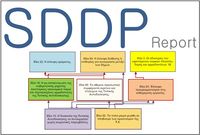SDDP Civil Society Dialogue Co Laboratory - Famagusta
|
Executive Summary
This paper reports the results of the first of a series of co-laboratories organized by Cypriot peace pioneers 30 months after the negative outcome of the referendum concerning UN General Secretary’s plan for reunification of the island. The purpose of this Co-Laboratory was to support a diverse group of disengaged and disappointed peace pioneers and activists representing Turkish and Greek communities of Cyprus develop a shared understanding of factors contributing to the perceived widening of the gap between the two divided communities in Cyprus. The co-laboratory was organized using the structured dialogic design process (SDDP) approach within the context of a rich web-based communication environment. The root causes contributing to the widening of the gap are discussed and are also compared with those identified during a similar co-laboratory employing the Interactive Management methodology 12 years earlier.
The Triggering Question (TQ) was
What are the obstacles that prevent us from achieving the ideal model of Famagusta/Varosha?
According to the participants of this Co-Laboratory, appear to be the most influential were:
- Obstacle #, 72
- Obstacle #, 47
The Co-Laboratory was facilitated by Aleco Christakis, Marios Michaelides, Tatjana Taraszow, Andros Karayiannis. The Co-Laboratory was also attended by 13 Cypriots participants and 8 Tourkish Cypriots.
The full paper can be downloaded from Open Access.
Sponsor and partners
The initiative which eventually led to the birth of the Civil Society Dialogue project was inspired by a team of six veteran peace pioneers, who decided to meet (physically) in September 2006 to discuss the post-referendum political situation in Cyprus and explore possibilities to revive their dream for a reunited island. These six pioneers were members of the peace group, widely known as Cyprus Conflict Resolution Trainers Group (CRTG), which in the years between 1994 and 1997 managed to inspire and mobilize a few thousand Cypriots to work for peace and reconciliation.
External Links
- Visit the wiki of the Civil Society Dialogue project here
- Visit the website of the Civil Society Dialogue project here
- Download the full paper here

